| Type | Alliance treaty |
|---|---|
| Signed | April 14, 1672 |
| Location | Stockholm |
| Signatories | |
| Parties |
The Treaty of Stockholm (1672) was an alliance treaty signed between Sweden and France on 14 April 1672. [1]
| Type | Alliance treaty |
|---|---|
| Signed | April 14, 1672 |
| Location | Stockholm |
| Signatories | |
| Parties |
The Treaty of Stockholm (1672) was an alliance treaty signed between Sweden and France on 14 April 1672. [1]

The Third Anglo-Dutch War, began on 27 March 1672, and concluded on 19 February 1674. A naval conflict between the Dutch Republic and England, in alliance with France, it is considered a related conflict of the wider 1672 to 1678 Franco-Dutch War.
The Treaty of Dover, also known as the Secret Treaty of Dover, was a treaty between England and France signed at Dover on 1 June 1670. It required that Charles II of England would convert to the Roman Catholic Church at some future date and that he would assist Louis XIV with 60 warships and 4,000 soldiers to help in France's war of conquest against the Dutch Republic. In exchange, Charles would secretly receive a yearly pension of £230,000, as well as an extra sum of money when Charles informed the English people of his conversion, and France would send 6,000 French troops if there was ever a rebellion against Charles in England. The secret treaty was signed by the earl of Arlington, Baron Arundell, Baron Clifford, and Sir Richard Bellings for England and the marquis of Croissy for France. The two kings exchanged letters of ratification and kept secret the existence of the treaty. A public treaty of Dover was also negotiated, but it was a screen designed for propaganda purposes and to hide the religious dimension of the secret treaty. The Third Anglo-Dutch War was a direct consequence of this treaty. The actual treaty was published by historians a century later.

The Nine Years' War was a European great power conflict from 1688 to 1697 between France and the Grand Alliance. Although largely concentrated in Europe, fighting spread to colonial possessions in the Americas, India, and West Africa. Related conflicts include the Williamite war in Ireland, and King William's War in North America.

The Grand Alliance, sometimes erroneously referred to as its precursor the League of Augsburg, was formed on 20 December 1689. Signed by William III on behalf of the Dutch Republic and England, and Emperor Leopold I for the Habsburg Monarchy, its primary purpose was to oppose the expansionist policies of Louis XIV of France.

The War of Devolution took place from May 1667 to May 1668. In the course of the war, France occupied large parts of the Spanish Netherlands and Franche-Comté, both then provinces of the Holy Roman Empire ruled by Spain. Its name derives from an obscure law known as the Jus Devolutionis, used by Louis XIV to claim that these territories had "devolved" to him by right of marriage to Maria Theresa of Spain.
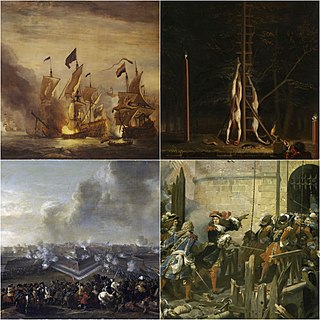
The Franco-Dutch War was a European conflict that lasted from 1672 to 1678. Its primary belligerents were France, backed at different times by Münster, Cologne, England, and the Swedish Empire, and the Dutch Republic, allied with the Holy Roman Empire, Spain, Brandenburg-Prussia and Denmark-Norway. The 1672 to 1674 Third Anglo-Dutch War and 1675 to 1679 Scanian War are considered related conflicts.

The Triple Alliance was signed by the Kingdom of England, the Swedish Empire and the Dutch Republic in May 1668. It was created in response to the occupation of the Spanish Netherlands and Franche-Comté by France. Although Spain and Emperor Leopold were not signatories, they were closely involved in the negotiations.
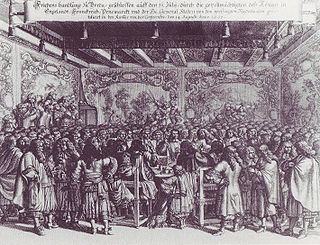
The Peace of Breda, or Treaty of Breda was signed in the Dutch city of Breda, on 31 July 1667. It consisted of three separate treaties between England and each of its opponents in the Second Anglo-Dutch War: the Dutch Republic, France, and Denmark–Norway. It also included a separate Anglo-Dutch commercial agreement.

In Dutch history, the year 1672 is referred to as the Rampjaar. In May 1672, following the outbreak of the Franco-Dutch War and its peripheral conflict the Third Anglo-Dutch War, France, supported by Münster and Cologne, invaded and nearly overran the Dutch Republic. At the same time, it faced the threat of an English naval blockade in support of the French endeavor, though that attempt was abandoned following the Battle of Solebay. A Dutch saying coined that year describes the Dutch people as redeloos ("irrational"), its government as radeloos ("distraught"), and the country as reddeloos. The cities of the coastal provinces of Holland, Zealand and Frisia underwent a political transition: the city governments were taken over by Orangists, opposed to the republican regime of the Grand Pensionary Johan de Witt, ending the First Stadtholderless Period.

The Scanian War was a part of the Northern Wars involving the union of Denmark–Norway, Brandenburg and Sweden. It was fought from 1675 to 1679 mainly on Scanian soil, in the former Danish–Norwegian provinces along the border with Sweden, and in Northern Germany. While the latter battles are regarded as a theater of the Scanian war in English, Danish, Norwegian and Swedish historiography, they are seen as a separate war in German historiography, called the Swedish-Brandenburgian War.

The Battle of Cassel, also known as the Battle of Peene, took place on 11 April 1677 during the Franco-Dutch War, near Cassel, 15 km (9 mi) west of Saint-Omer. A French army commanded by the duc de Luxembourg defeated a combined Dutch–Spanish force under William of Orange.

The Battle of Almenar also referred to as Almenara was a battle in the Iberian theatre of the War of the Spanish Succession.

The Siege of Namur, 25 May–30 June 1692, was a major engagement of the Nine Years' War, and was part of the French grand plan to defeat the forces of the Grand Alliance and bring a swift conclusion to the war. Namur, sitting on the confluence of the Meuse and Sambre rivers, was a considerable fortress, and was a significant political and military asset. French forces, guided by Vauban, forced the town's surrender on 5 June, but the citadel, staunchly defended by Menno van Coehoorn, managed to hold on until 30 June before capitulating, bringing an end to the 36-day siege. Concerned that King William III planned to recapture the stronghold, King Louis XIV subsequently ordered his commander-in-chief, the duc de Luxembourg, to join battle with the Allies in the field, resulting in the bloody Battle of Steenkerque on 3 August.
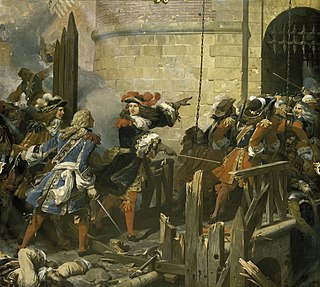
The siege of Valenciennes took place from 28 February to 17 March 1677, during the Franco-Dutch War, when Valenciennes, then in the Spanish Netherlands, was attacked by a French army under the duc de Luxembourg.

The Treaty or Peace of Saint-Germain-en-Laye of 19 June (OS) or 29 June (NS) 1679 was a peace treaty between France and the Electorate of Brandenburg. It restored to France's ally Sweden her dominions Bremen-Verden and Swedish Pomerania, lost to Brandenburg in the Scanian War. Sweden ratified the treaty on 28 July 1679.
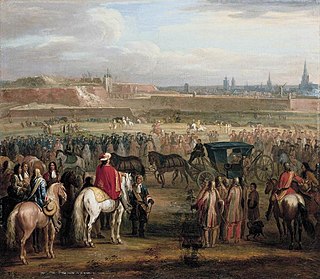
The siege of Cambrai took place from 20 March to 19 April 1677 during the 1672–1678 Franco-Dutch War; then part of the Spanish Netherlands, it was invested by a French army under the duc de Luxembourg. Siege operations were supervised by the military engineer Vauban; Louis XIV was nominally in command but played little part in operations.
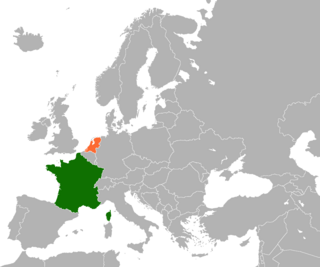
France–Netherlands relations are the interstate and bilateral relations between France and the Netherlands. The two countries notably share a border division in the Caribbean island of Saint Martin, to which the northern part of the island is a French overseas collectivity known as the Collectivity of Saint Martin, while the southern part of the island is a Dutch constituent country known as Sint Maarten. Relations between the two countries date back to the 17th and 18th centuries when a conflict led to the transformation of the Dutch Republic to the Batavian Republic and eventually the Kingdom of Holland. The two countries currently enjoy close cultural and economic relations. Both nations are members of the OECD and Organization for Security and Co-operation in Europe, as well as founding members of the European Union, NATO, and the United Nations.
The 1676 siege of Maastricht was a failed attempt by William III of Orange to take the city, which had been occupied by the French since 1673. The siege took place from 6 July to 27 August 1676 during the Franco-Dutch war of 1672 to 1678.
The Battle of Ortenbach, also known as the Battle of Gengenbach, took place on 23 July 1678 during the closing stages of the 1672-1678 Franco-Dutch War, in the modern German state of Baden-Württemberg. It featured a French army commanded by François de Créquy and an Imperial force under Charles V, Duke of Lorraine.

The Treaty of Vossem was signed on 6 June 1673, between Frederick William, Elector Brandenburg and Louis XIV of France; England, then a French ally against the Dutch, was included as a party to the terms but not a signatory. It was ratified by both parties on 20 July.